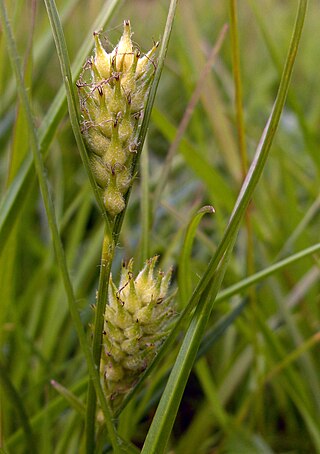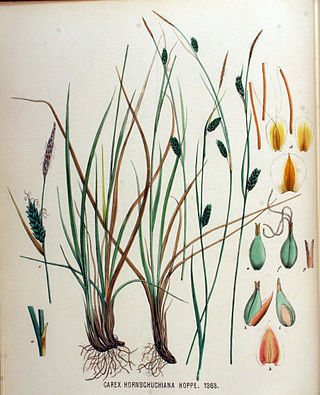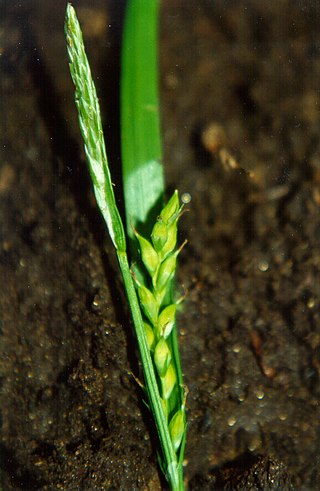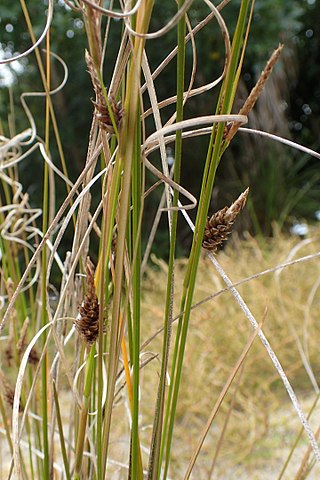
Carex pensylvanica is a species of flowering plant in the sedge family commonly called Pennsylvania sedge. Other common names include early sedge, common oak sedge, and yellow sedge.

Carex hirta, the hairy sedge or hammer sedge, is a species of sedge native across Europe. It has characteristic hairy leaves and inflorescences, and is the type species of the genus Carex.

Carex binervis, the green-ribbed sedge, is a European species of sedge with an Atlantic distribution. It is found from Fennoscandia to the Iberian Peninsula, and occurs in heaths, moorland and other damp, acidic environments. It typically grows to a height of 15–120 cm (6–50 in), and has inflorescences comprising one male and several female spikes, each up to 45 mm (1.8 in) long. The utricles have two conspicuous green veins, which give rise to both the scientific name and the common name of the species. In the vegetative state, it closely resembles C. bigelowii, a species that usually grows at higher altitude. C. binervis was first described by James Edward Smith in 1800, and is classified in Carex sect. Spirostachyae; several hybrids with other Carex species are known.

Carex spicata is a species of sedge in the genus Carex.

Carex pilulifera, the pill sedge, is a European species of sedge found in acid heaths, woods and grassland from Macaronesia to Scandinavia. It grows up to 30 cm (12 in) tall, with 2–4 female spikes and 1 male spike in an inflorescence. These stalks bend as the seeds ripen, and the seeds are collected and dispersed by ants of the species Myrmica ruginodis.

Carex texensis, the Texas sedge, is a species of flowering plant in the sedge family, Cyperaceae. It is endemic to the eastern, central, and southern United States.

Carex baileyi is a sedge in section Vesicariae the genus Carex native to the Appalachian mountains in Eastern North America. It is commonly called Bailey's sedge. Carex baileyi was named in honor of Liberty Hyde Bailey by its discoverer, Nathaniel_Lord_Britton.

Carex hostiana, the tawny sedge, is a species of flowering plant in the genus Carex, native to Europe and northeast Canada, and extinct in Massachusetts. It is a member of the Carex flava species complex.
Carex thunbergii is a tussock-forming species of perennial sedge in the family Cyperaceae. It is native to parts of eastern Asia from around Manchuria in the west to Japan in the east. It is found in Primorye to the north to Korea in the south.

Carex gaudichaudiana, also known as fen sedge, is a tussock-forming species of perennial sedge in the family Cyperaceae. It is native to parts of Australia and New Zealand.
Carex arkansana is a tussock-forming species of perennial sedge in the family Cyperaceae. It is native to central parts of the United States.
Carex californica is a tussock-forming species of perennial sedge in the family Cyperaceae. It is native to western parts of the United States.

Carex congdonii is a tussock-forming species of perennial sedge in the family Cyperaceae. It is native to parts of California.

Carex donnell-smithii is a tussock-forming species of perennial sedge in the family Cyperaceae. It is native to parts of Mexico and Central America.

Carex hendersonii, also known as Henderson's sedge or carex de Henderson, is a tussock-forming species of perennial sedge in the family Cyperaceae. It is native to western parts of North America.

Carex litorosa, commonly known as sea sedge, is a tussock-forming species of perennial sedge in the family Cyperaceae. It is native to New Zealand.
Carex interrupta is a tussock-forming species of perennial sedge in the family Cyperaceae. It is native to south eastern parts of Canada and north eastern parts of the United States.
Carex krausei, commonly known as Krause's sedge or carex de Krause in Canada, is a tussock-forming species of perennial sedge in the family Cyperaceae. It is native to subarctic areas of Greenland, Alaska, northern Canada and Russia.

Carex michauxiana, also known as Michaux's sedge, carex de Michaux or yellowish sedge in Canada, is a tussock-forming species of perennial sedge in the family Cyperaceae. It is native to eastern parts of North America and parts of Asia.

Carex digitalis is a tussock-forming species of perennial sedge in the family Cyperaceae. It is native to south eastern parts of Canada as well as central and eastern parts of the United States.















